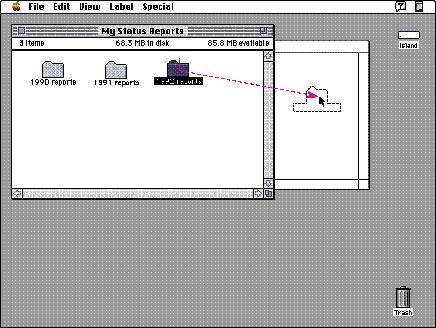Direct manipulation
Direct manipulation — proposed among others by Ben Shneiderman — allows a viewer to interact with a visulization corresponding to the real–world analogue it follows. It avoids the barrier of having to translate ideas into commands meaningful to a computer by building a graphical user interface that is semantically in line with the representation.

Direct manipulation allows people to feel that they are directly controlling the objects represented by the computer. According to the principle of direct manipulation, an object on the screen remains visible while a user performs physical actions on the object. When the user performs operations on the object, the impact of those operations on the object is immediately visible.
Apple Computer, Inc.
The central ideas of direct manipulation are visibility of objects and actions of interest; rapid, reversible, incemental actions; and replacement of command-language syntax by direct manipulation of the object of interest.
[...]
It is essential to think visually. Try to conjure up a sequence of images rather than thinking in terms of a sequnce of instructions.
[...]
It is essential to think visually. Try to conjure up a sequence of images rather than thinking in terms of a sequnce of instructions.
[Hodgson, 1995]
The criteria for direct manipulation are the continuous representation of objects of interests and the fast, incremental, undoable actions, which have an immediate visual impact on the object itself.
The goal is to allow the user to directly interact with the object.
The goal is to allow the user to directly interact with the object.
[Shneiderman, 1983]
Definition
- Visual representation (metaphor) of the "world of action"
Objects and actions are shown
Analogical reasoning is tapped - Rapid, incremental, and reversible actions
- Replacement of typing with pointing and selecting
- Immediate visibility of results of actions
Benefits over commands
- Control/display compatibility
- Less syntax reduces error rates
- Errors are more preventable
- Faster learning and higher retention
- Encourages exploration
Concerns
- Increased system resources, possibly
- Some actions might be cumbersome
- Macro techniques are often weak
- History and other tracing may be difficult
- Visually impaired users may have more difficulty
[Shneiderman and Plaisant, 2005]
External Links
- Direct Manipulation (Dr. Jonathan Hodgson. Saint Joseph’s University. The Design of Graphic User Interfaces)
References
- [Hodgson, 1995] Jonathan Hodgson. The Design of Graphic User Interfaces: Homepage. Saint Joseph’s University. Created at: April 5, 1995. Retrieved at: November 2004. http://www.sju.edu/~jhodgson/gui/manip.html.
- [Shneiderman, 1983] Ben Shneiderman. Direct manipulation: a step beyond programming languages. IEEE Computer, 16(8): 57-69, August 1983.
- [Shneiderman and Plaisant, 2005] Ben Shneiderman and Catherine Plaisant, Designing the User Interface, 4th Edition, Pearson Education, 2005, p. 259.